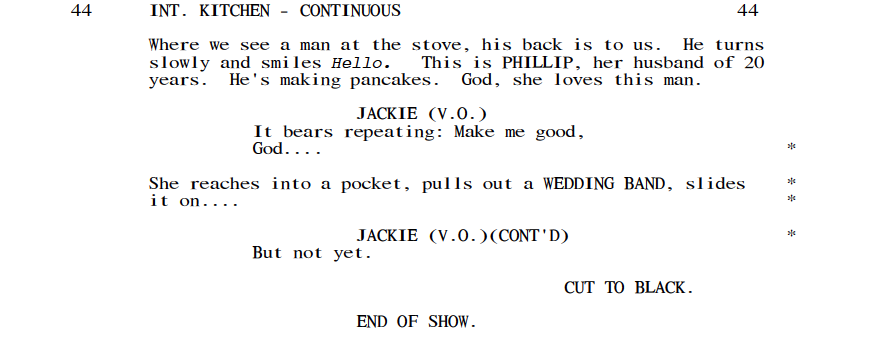Writing a TV Pilot (Nurse Jackie) guest blog from Sandra Leviton & Miranda Sajdak
In my ongoing commitment to bring you guys more information on writing for television, I’m happy to host this guest blog from industry veterans Sandra Leviton (FX, Paradigm, Under The Stairs Entertainment) & Miranda Sajdak (Practical Pictures, ABC Family, Adult Swim) and the new Script Chix Pilot Launch Contest…
When writing any television pilot, it’s important to pay close attention to format, structure, pacing, and character. Without full development of these vital components, even the best of ideas can easily fall apart. To examine some of these elements, we are breaking down the pilot episode of Nurse Jackie, Showtime’s popular series starring Edie Falco. The pilot is written by Liz Brixius & Linda Wallem and Evan Dunsky.
PLOT: OVERALL STORY
Nurse Jackie tells the story of a painkiller-addicted nurse, whose daily life forms the backbone of this dark comedy. The pilot script is a fantastic example of a comedy that focuses on characters in difficult situations who must make life-or-death decisions, without losing sight of the humanity in its leads.
STRUCTURE: ACTS & FLOW
The overall structure of the pilot holds true to classic television format; although the script is a cable script and doesn’t have commercials, it still functions within the classic 5-act structure. As such, each individual act includes an escalation in both action and character, in which we learn something new about the people whose lives we are following.
CHARACTERS: THE CORE OF EVERY SHOW
Most importantly, as in any great television series, the characters truly stand out here. First and foremost, character introductions give us a clear sense of who these people are. Jackie herself is acerbic; she’s introduced on her back, quoting TS Eliot. Why is she on her back? – Jackie answers that question immediately, describing a herniated disc – the cause of pain that will ultimately bring on an addiction that plagues her through numerous seasons of the show.
Additionally, Jackie’s initial voiceover within the first page mentions that “people with the greatest capacity for good are the ones with the greatest capacity for evil.” The initial page of the pilot, without even showing Jackie interacting with anyone, clearly lays out two of the major themes that persist through the entire show: addiction, and the balance between good and evil.
Other regulars are introduced in similarly illuminating ways. Dr. Cooper, for instance, known throughout the series as rather self-absorbed, enters the operating room on his Bluetooth, and winks at both Jackie and the patient. Before he’s even said a word, we can tell that “Coop” is pretty smarmy, something that’s later supported by his actions throughout the series.
Despite Coop’s distracted attitude, Jackie realizes that her patient is in need of help – and tries to save his life. Throughout this episode, the reader is shown that Jackie’s capacity for caring and her knowledge of medicine are unparalleled by anyone else in the story. As such, despite her addiction and her constant sarcasm, we recognize the humanity and the good heart within.
Other characters are similarly anointed with telling introductions (Mo-Mo’s flamboyance, O’Hara always watching Jackie’s back, Zoey babbling on and on about nursing, etc), all of which tell us a great deal about who these people are, often in the space of a single line of dialogue.
DIALOGUE: ENHANCING THE TONE
The dialogue itself truly creates the comedic tone here; though these are doctors and nurses dealing with serious, life-threatening situations, their sarcasm and dry wit clearly help them get through the day. As such, when Dr. O’Hara on p. 11 refers to the hospital administrator as the “Wicked Witch,” we, as readers, know that it’s ok to laugh – these moments of brevity serve to contrast the potential darkness of Jackie’s demons and the life-or-death hospital environment.
Additionally, the dialogue gives us a sense of how these characters see themselves, as well as the world they live in. On p. 13 when Jackie says “I don’t like chatty, I don’t do chatty. I like quiet. Quiet and mean. Those are my people,” we know that she’s both utterly serious, and, again, using her numerous defense mechanisms against getting too close to others. However, her unabashed honesty makes it easier to understand her – though her comment may initially seem mean in and of itself, it’s also refreshing to hear someone identify themselves in a less-than-rosy light.
Though the first page of the script opens slowly, the pacing explodes on page 2, when “a set of doors BLASTS open. E.M.T.s rush a gurney down the hall.” The pace picks up and doesn’t stop, as the script continues to introduce major characters through Jackie’s day at work. In any script, time matters – but even more in television than in features. Working around necessary act (and, often, commercial) breaks forces the writer to keep the audience engaged – something these three screenwriters manage with skill. Additionally, working within a confined amount of time while still keeping the story moving is a difficult balance; yet, this pilot does all that, without losing focus on the main thrust of the story.
SET-UPS & PAYOFFS: CRAFT A STRONG FOUNDATION FOR THE SERIES
The final beat of the script, in which we learn that Jackie is married with two kids – despite previously meeting Eddie, the man she’s sleeping with at work – presents a nice bookend to the beginning of the script. In this instance, Jackie narrates “make me good, God…but not yet,” a mantra that represents everything Jackie feels when faced with the choices she makes every day.
These choices, and the scenarios Jackie finds herself in – saving the life of a patient, cheating on her husband, teaching Zoey about nursing – all repeat throughout the course of the first season. Finding ways to set up scenarios that will recur helps strengthen the foundation of this pilot, as it gives us a sense that the lives presented here are directly connected to the remainder of the series, and are complex enough to require further examination. The complexity, struggle, and risk that Jackie sets herself up for throughout this pilot exemplifies the entire thrust of the series. At every step, Jackie tries to do good – but often finds herself employing immoral or illegal methods.
Everything we learn about the characters in episode one serves to support the rest of season one – much of it even extending into the end of season 3. The true purpose of the pilot is to be able to set up enough intrigue, character, and plot points to motivate the rest of the series. It should be clearly evident in every element on the page. By effectively addressing each of these elements, the Nurse Jackie pilot crafts a compelling, darkly comic, and honest portrayal of a woman balancing on the edge of just about everything – addiction, loyalty, love, and trust. The big themes presented through even the smallest of actions make this script a truly great read.
WRITE YOUR OWN PILOT!
To show off your own pilot writing skills – and for a chance to win a trip to Hollywood and meetings with network executives – check out Script Chix very own Pilot Launch competition.
Thank you, Sandra!
Good Luck and Happy Writing
Dan Calvisi
Related: More on TV Writing
Related: Story Maps Screenwriting Podcast
 “Dan has created a book that is straightforward and full of valuable insight and guidance for screenwriters at different experience levels.”
“Dan has created a book that is straightforward and full of valuable insight and guidance for screenwriters at different experience levels.”
-Laurie Lamson, Editor, Now Write! Screenwriting










Hi Dan. I purchased your Story Maps ebook for film. Have you completed the Story Maps ebook for TV yet? I anxiously await the resource!
Hi do you have a basic format I could get to create a pilot? I really appreciated your article here and I really learned alot.
Hi Corey,
Thank you for your interest and I invite you to look up other articles written by Sandra and Miranda as they are quite insightful.
As to your question, I am currently editing my next e-book on TV drama structure, tentatively titled STORY MAPS: THE TELEVISION DRAMA! (Groundbreaking title, huh?) It is an expansion of the material I presented in my webinar Inside the TV Drama: Writing the Best Shows on Television, which you can download here. It touches on many of the best one-hour TV dramas out there, with a particular focus on the pilots for Mad Men, Breaking Bad and House of Cards. I plan to also add a Story Map of ABC’s Scandal.
The Story Maps: TV e-book, which is the first to offer a Story Map beat sheet-style paradigm for TV drama, is currently available only as a part of my TV Pilot Consultation. If you have a pilot, or are looking to develop one, I invite you to contact me about a consultation by emailing me via any form on this site. Thank you for your question, good luck and happy writing.